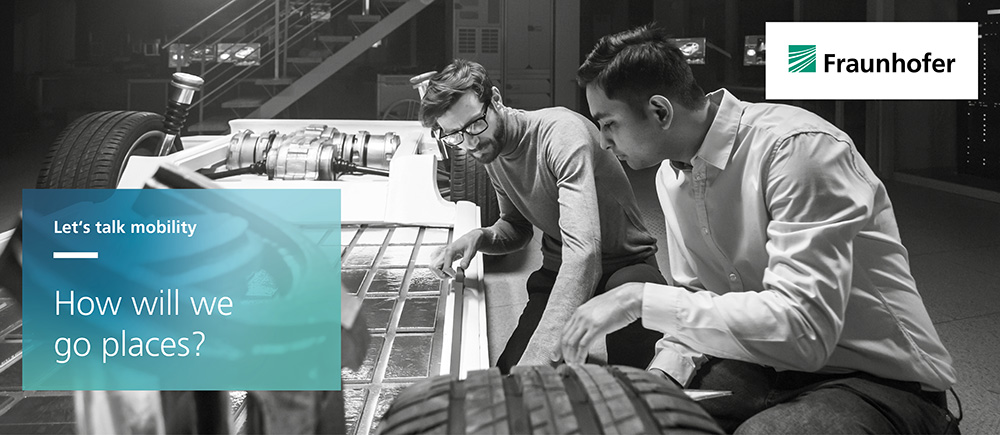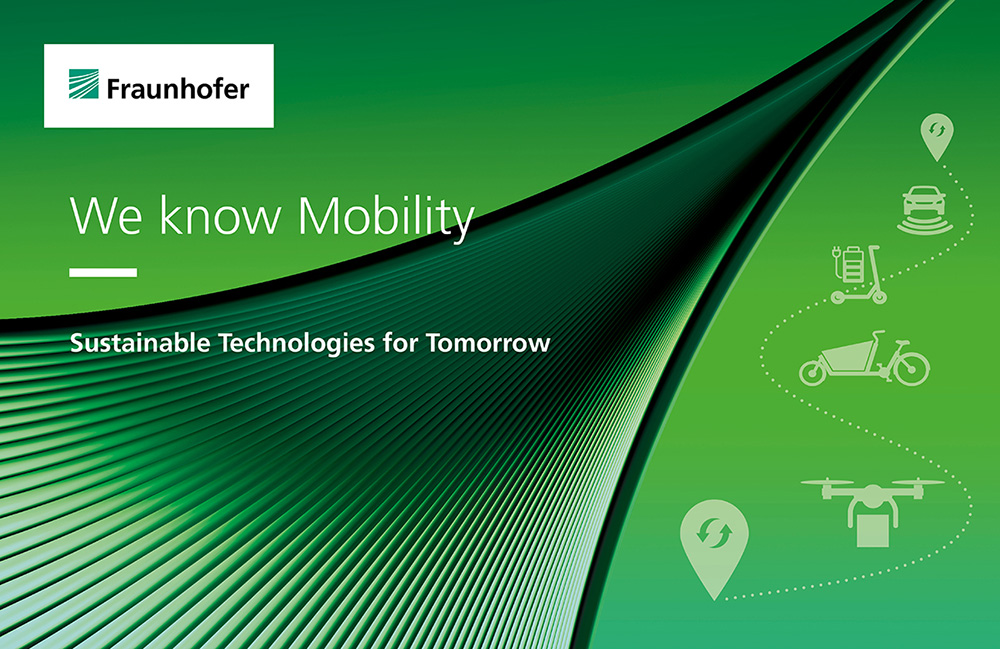Groundbreaking concepts for the future of mobility
Fraunhofer at the IAA Open Space and the Mobility Summit
How can we shape mobility in an eco-friendly way? How are new mobility con-cepts changing our cities? How will we get from A to B in the future? At two Munich sites at the IAA 2021 from September 7 to 12, 2021, the Fraunhofer-Gesellschaft’s institutes will be showcasing their expertise and putting forward their concepts and solutions for tomorrow’s mobility. The Fraunhofer-Gesellschaft will have a stand at the IAA Open Space, at Königsplatz in central Munich (stand KP 185), where experts from the Fraunhofer-Gesellschaft will be discussing and answering urgent questions about the future of mobility. The Fraunhofer-Gesellschaft will also be demonstrating the latest solutions and developments to the expert community on the trade fair site at hall B1, stand C60.


»Innovation and restructuring of our mobility are central to the technological, ecological and social organization of our future. The answers we provide today are crucial to ensuring safety behind the wheel as well as to urban and rural development, not to mention the achievement of climate goals,” says Prof. Reimund Neugebauer, President of the Fraunhofer-Gesellschaft. “As a strategically vital sector of the German and European economy, innovations in this field of technology have a direct effect on Germany’s economic strength. Since their main areas of research complement each other in terms of their subject matter, the institutes within the Fraunhofer-Gesellschaft can produce groundbreaking innovations along the entire value chain by working on an interdisciplinary basis. In doing so, they are playing an important role in ensuring sustainable prosperity based on eco-friendly technologies, from fuel and CO2 reduction to innovative urban development and the continued digitalization and networking of mobility.«
Open Space: »Let’s talk mobility«
From new cargo bikes that reduce traffic in cities to concepts for the inner cities of the future and even autonomous driving, Fraunhofer’s researchers will be demonstrating the latest developments and solutions that will permanently and sustainably change the way we get around in the future, through exciting exhibits in Munich’s Königsplatz under the motto “Let’s talk mobility
Sustainable concepts for the future of mobility
The experts at the Fraunhofer Institute for Industrial Engineering IAO will be bringing their current #ELASTICITY study to the very place it is intended for: the inner city. The study shows the need for interconnecting innovation concepts that consider the urban space as a whole and are characterized by flexibility and diversity. There is also a scenario wall for visitors to leave their comments, ideas and aspirations for the inner cities of the future. Using a VR headset, they can even dive right into the future of mobility in the year 2049. As well as all this, the three-wheeled E-Floater shows how e-scooters can search for charging stations and manage parking spaces autonomously.
Effect of interior design on the acceptance of autonomous vehicles
For people to use or buy autonomous vehicles, it is not enough simply for the technology to be mature; passengers need to feel comfortable in them too. To address this, the experts at Fraunhofer IAO are investigating how interior design affects acceptance. A material wall allows visitors to look at, touch and evaluate a number of different sustainable materials designed to give a high-quality visual impression. There is also a monitor displaying, among other things, a project from the Fraunhofer “Science, Art and Design” network with design ideas for the passenger cabin of an air taxi that even responds to the passenger’s emotional needs.
Fuel cells: market-ready production chains enable economic breakthrough
Researchers at the Fraunhofer Institute for Machine Tools and Forming Technology IWU, the Fraunhofer Institute for Material and Beam Technology IWS, the Fraunhofer Institute for Ceramic Technologies and Systems IKTS and the Fraunhofer Institute for Production Technology IPT are working on a cost-effective, demand-oriented and scalable way to mass-produce fuel cells. To this end, new forming processes for manufacturing bipolar plates also need to be made market-ready. The embossing rolling process developed at Fraunhofer IWU provides a unique ability in this regard, to install the characteristic flow fields of these plates continuously by means of a rotating motion. For the coating, Fraunhofer IWS applies a few nanometers of carbon using physical vapor deposition (PVD). Implementing these processes on production lines significantly reduces production costs. This coating process could be integrated into a roll-to-roll production facility in the future, such as the one currently being developed by Fraunhofer IPT. This would be another major step towards a fully automated and therefore cost-effective production chain. At Fraunhofer IKTS, another coating process for mass production is being researched. In this process, platinum is applied with precision to the membrane electrode assembly (MEA), the second main component of a fuel cell.
The cargo bike as an example of a functionally integrated lightweight structure
In the “L-LBF” project, a research team used specially taken drive test measurements and initial data on the mass and geometry of the selected commercial cargo bike to develop CAD models, which it then used as a basis for FE models. These were used to develop the new lightweight frame. The crucial point here is not only that the mass has been reduced by almost 40 percent compared to the original cargo bike. It is also that the frame allows for the battery system, which was also developed as part of this project, to be integrated into the core element of the frame, a central hollow beam made from high-tensile aluminum alloy, while remaining theft-proof and weather-resistant with no additional casing. The battery system has twice the storage capacity of a standard battery system.
Lightweight components for sustainable mobility
Plastic products reinforced with carbon fibers are established lightweight design solutions in the racing world. Although they do provide good performance, they are very resource-intensive. The Bioconcept Car exhibited by the Fraunhofer Institute for Wood Research, Wilhelm-Klauditz-Institut, WKI demonstrates the feasibility of replacing the carbon fibers with natural fiber materials and using them in a practical way. An example of this practical use is the small-batch door included in the exhibit: it is made from 100 percent flax fibers, which are natural fibers that are available on the market.
Fraunhofer on the trade fair site: “We know mobility”
The Fraunhofer-Gesellschaft will also be demonstrating its expertise and presenting solutions for designing tomorrow’s mobility on the trade fair site at hall B1, stand C60.
Solar panels installed as road coverings
Photovoltaic panels as a covering for road surfaces that have already been sealed could make a significant contribution to renewable energy generation in the transportation sector. Together with its partners, the Fraunhofer Institute for Solar Energy Systems ISE has developed a concept for the transport ministries of Germany, Austria and Switzerland that allows road surfaces to play such a dual role. A prototype is currently being built in the Lake Constance region and is scheduled to be completed in early 2022. Fraunhofer ISE will be presenting a model of the first demonstrator at the Fraunhofer-Gesellschaft trade fair stand.
Solar power from the car roof
When the sun is shining, electric cars can increase their range by ten kilometers a day with a solar car roof. The solar cells are integrated directly into a glass roof between two curved panes of glass. The color of the solar roof is a completely free choice thanks to an individual color coating, and can be adapted to the color of the vehicle body. Fraunhofer ISE is conducting research across the entire spectrum of vehicle integration of PV modules, and at IAA Mobility 2021 it will be using two solar car roofs to demonstrate a selection of possible solar cell technologies with high efficiency and a range of different looks.
Lightweight battery pack driving e-mobility forward: light weight and efficient production
Researchers at the Fraunhofer Institute for Structural Durability and System Reliability LBF have developed a lightweight battery pack that uses only fiber-reinforced polymers. This has led to a 40 percent reduction in weight compared to aluminum casings. This design not only reduces the moving weight of an electric vehicle, but also increases its range and momentum thanks to additional integrated functions. As the battery pack is made using a specially developed, highly efficient process and has a specific structural design, it can be produced at very low cost.
You can find these and many other pioneering technologies and solutions from September 7 to 12, 2021 at the IAA Open Space in Königsplatz in central Munich (stand KP 185) and at the IAA Summit on the trade fair site, hall B1, stand C60.